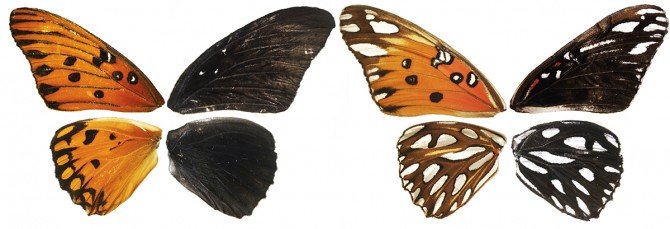Black-and-white proof: Single genes control color, stripes in butterfly wings
By Krishna Ramanujan
Two papers prove for the first time how single master genes – one for colors and iridescence and the other for stripe patterns – control these complex traits in butterfly wings, according to research by a team that includes Cornell scientists.
One paper offers the first direct proof that the optix gene controls color and iridescence; when researchers used CRISPR-Cas9 gene editing technology to “break” the gene, those butterflies had black-and-white wings.
The other paper similarly proved that when the WntA gene was cut out with CRISPR-Cas9, stripe patterns disappeared. Both papers were published Sept. 20 in the journal Proceedings of the National Academy of Sciences.
The findings are striking because they describe how single genes can have such massive effects. The discovery runs counter to the idea that control of something as complex as butterfly color patterns would require dozens to hundreds of genes.
The papers come on the heels of another by the same group published in June 2016 in Nature Communications that proved that a gene called spalt controlled wing eyespot patterns.
“It looks like, between these two papers and the one we published last year, we basically have the fundamental toolkit of genes that controls most color patterns in butterfly wings,” said Robert Reed, associate professor of ecology and evolutionary biology and a co-author of all three papers. Linlin Zhang, a postdoctoral researcher, is the first author of the optix paper, and graduate student Anyi Mazo-Vargas is first author of the WntA paper; both are members of Reed’s lab.
The findings have larger implications for genes involved in evolution. It appears that a few master genes – single genes with large effects such as optix and WntA – play an unusually central role in repeatedly driving evolution in different species, Reed said.
Since there are a finite number of genes, they are often recycled throughout evolutionary time, with the same gene having different functions over time and across species. For example, the optix gene also exists in fruit flies, but there it is involved in eye development, as opposed to wing color.
“If you mutate optix in a fruit fly, then you’d essentially have no eye,” Reed said. And other studies show that a single gene controls coat color in different species of mammals and that gene is repeatedly implicated in evolution of that trait even though other genes might have a similar effect.
Similarly, while there are many other genes that separately influence color in butterfly wings, when evolution and natural selection occur, they are typically driven by mutations in optix, Reed said. “It seems like a small number of genes disproportionately drive evolution over and over again.”
While optix controls color pigments, the researchers were surprised to find it also controls iridescence, a completely different mechanism where light is reflected in a particular manner off of microscopic features of the butterfly wing scale cells.
The optix paper was funded by the National Science Foundation (NSF). The WntA paper was funded by the NSF, the National Institutes of Health, the Leverhulme Trust, the Pew Charitable Trust and the Smithsonian Institution.
Media Contact
Get Cornell news delivered right to your inbox.
Subscribe